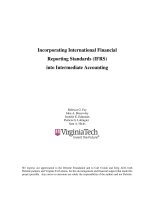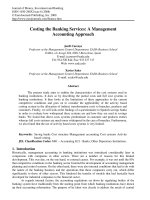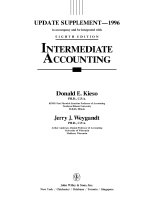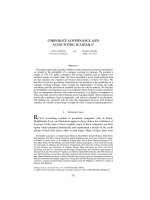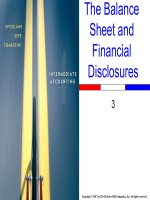Intermediate Accounting - Chap006 pot
Bạn đang xem bản rút gọn của tài liệu. Xem và tải ngay bản đầy đủ của tài liệu tại đây (638.9 KB, 57 trang )
Copyright © 2007 by The McGraw-Hill Companies, Inc. All rights reserved.
Time Value of
Money
Concepts
6
6-2
Time Value of Money
Interest is the
rent paid for the use
of money over time.
That’s right! A dollar
today is more valuable
than a dollar to be
received in one year.
6-3
Learning Objectives
Explain the difference between simple and
compound interest.
6-4
Simple Interest
Interest amount = P × i × n
Assume you invest $1,000 at 6% simple interest
for 3 years.
You would earn $180 interest.
($1,000 × .06 × 3 = $180)
(or $60 each year for 3 years)
6-5
Compound Interest
Compound interest includes interest not only on
the initial investment but also on the
accumulated interest in previous periods.
Principal Interest
6-6
Assume we will save $1,000 for three years and
earn 6% interest compounded annually.
What is the balance in
our account at the
end of three years?
Compound Interest
6-7
Compound Interest
6-8
Learning Objectives
Compute the future value of a single amount.
6-9
Future Value of a Single Amount
The future value of a single amount is the amount of
money that a dollar will grow to at some point in
the future.
Assume we will save $1,000 for three years and
earn 6% interest compounded annually.
$1,000.00 × 1.06 = $1,060.00
and
$1,060.00 × 1.06 = $1,123.60
and
$1,123.60 × 1.06 = $1,191.02
6-10
Writing in a more efficient way, we can say . . . .
$1,000 × 1.06 × 1.06 × 1.06 = $1,191.02
or
$1,000 × [1.06]
3
= $1,191.02
Future Value of a Single Amount
6-11
$1,000 × [1.06]
3
= $1,191.02
We can generalize this as . . .
FV = PV (1 + i)
n
Future
Value
Future
Value
Present
Value
Present
Value
Interest
Rate
Interest
Rate
Number
of
Compounding
Periods
Number
of
Compounding
Periods
Future Value of a Single Amount
6-12
Find the
Future Value
of $1 table in
your textbook.
Future Value of a Single Amount
Find the factor for 6% and 3
periods.
6-13
Find the factor for 6% and 3 periods.
Solve our problem like this. . .
FV = $1,000 × 1.19102
FV = $1,191.02
FV $1
Future Value of a Single Amount
6-14
Learning Objectives
Compute the present value of a single amount.
6-15
Instead of asking what is the future value of a
current amount, we might want to know what
amount we must invest today to accumulate a
known future amount.
This is a
present value question.
Present value of a single amount is today’s
equivalent to a particular amount in the future.
Present Value of a Single Amount
6-16
Remember our equation?
FV = PV (1 + i)
n
We can solve for PV and get . . . .
FV
(1 + i)
n
PV =
Present Value of a Single Amount
6-17
Find the
Present Value
of $1 table in
your textbook.
Hey, it looks
familiar!
Present Value of a Single Amount
6-18
Assume you plan to buy a new car in 5
years and you think it will cost $20,000 at
that time.
What amount must you invest
today
today in order to
accumulate $20,000 in 5 years, if you can
earn 8% interest compounded annually?
Present Value of a Single Amount
6-19
i = .08, n = 5
Present Value Factor = .68058
$20,000 × .68058 = $13,611.60
If you deposit $13,611.60 now, at 8% annual
interest, you will have $20,000 at the end of 5
years.
Present Value of a Single Amount
6-20
Learning Objectives
Solving for either the interest rate or the
number of compounding periods when present
value and future value of a single amount are
known.
6-21
FV = PV (1 + i)
n
Future
Value
Future
Value
Present
Value
Present
Value
Interest
Rate
Interest
Rate
Number
of Compounding
Periods
Number
of Compounding
Periods
There are four variables needed when
determining the time value of money.
If you know any three of these, the fourth
can be determined.
Solving for Other Values
6-22
Suppose a friend wants to borrow $1,000 today
and promises to repay you $1,092 two years
from now. What is the annual interest rate you
would be agreeing to?
a. 3.5%
b. 4.0%
c. 4.5%
d. 5.0%
Determining the Unknown Interest Rate
6-23
Suppose a friend wants to borrow $1,000 today
and promises to repay you $1,092 two years
from now. What is the annual interest rate you
would be agreeing to?
a. 3.5%
b. 4.0%
c. 4.5%
d. 5.0%
Determining the Unknown Interest Rate
Present Value of $1 Table
$1,000 = $1,092 × ?
$1,000 ÷ $1,092 = .91575
Search the PV of $1 table
in row 2 (n=2) for this value.
6-24
Monetary assets and monetary
liabilities are valued at the
present value of future cash
flows.
Accounting Applications of Present Value
Techniques—Single Cash Amount
Monetary
Assets
Money and claims to
receive money, the
amount which is
fixed or determinable
Monetary
Liabilities
Obligations to pay
amounts of cash, the
amount of which is
fixed or determinable
6-25
Some notes do not include a stated
interest rate. We call these notes
noninterest-bearing notes.
Even though the agreement states it
is a noninterest-bearing note, the
note does, in fact, include interest.
We impute an appropriate interest
rate for a loan of this type to use
as the interest rate.
No Explicit Interest
